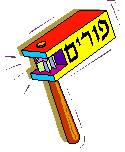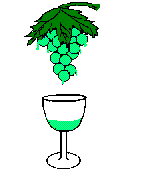
PROVOCATIVE
QUESTIONS & ANSWERS
 Purim is truly unique. It is a holiday whose message and power have endured for over 2,000 years -- despite the fact that its story (Megillat Esther) probably never took place!
The special quality of Purim is reflected in the intriguing customs associated with both its synagogue and home celebration. "Blotting out" Haman's name, the greggar, masquerading, mishloach manot, Purim spiels and becoming slightly inebriated are all part of the rich and colorful tradition of this holiday of deliverance.
Purim is truly unique. It is a holiday whose message and power have endured for over 2,000 years -- despite the fact that its story (Megillat Esther) probably never took place!
The special quality of Purim is reflected in the intriguing customs associated with both its synagogue and home celebration. "Blotting out" Haman's name, the greggar, masquerading, mishloach manot, Purim spiels and becoming slightly inebriated are all part of the rich and colorful tradition of this holiday of deliverance.

 Why do we make noise when Haman's name is read from the Megillah?
Why do we make noise when Haman's name is read from the Megillah?
The custom has fascinating Biblical origins. Exodus, Chapter 17, describes a bitter battle in the wilderness between the Israelites and the soldiers of King Amalek. Although Israel prevailed, the Torah records G-d saying to Moses:
"Write this for a memorial-in the book... I will utterly blot out the remembrance of Amalek from under the heavens."(Exodus 17:14)
In Deuteronomy 25:15, this curse on Amalek is repeated:
"...You shall blot out the remembrance of Amalek from under heaven; you shall not forget."
The sense of the passage is clear. G-d is telling the Children of Israel that the descendants of Amalek will always be their enemies and thus to "blot them out".
Indeed, history proved that to be true. Many years later, Agag, then king of Amalek, became a bitter foe of the Jewish people, a 51aughterer of women and. children. In fact, King Saul was dethroned for sparing Agag's life after Israe military victory over the Amalekites. The prophet Samuel executed Agag, and the name of Amalek was "blotted out" once more.
All of which brings us to Haman. Turning to the Book of Esther (3:1), we see that Haman is identified as
"the son of Hammedatha the Agagite", in short, a direct descendant of Amalek! It is reasonable to assume that the author of Esther deliberately forged a bond between Amalek and Haman so as to accentuate Haman's evil character. Remembering the ancient injunction to "blot out" Amalek's name, the Jews proceeded to do just that--not by violence, but through noise. The custom of "blotting out" the name of Haman was thus born and endures today.
to assume that the author of Esther deliberately forged a bond between Amalek and Haman so as to accentuate Haman's evil character. Remembering the ancient injunction to "blot out" Amalek's name, the Jews proceeded to do just that--not by violence, but through noise. The custom of "blotting out" the name of Haman was thus born and endures today.
 Where did the greggar originate?
Where did the greggar originate?
"Greggar" comes from a Polish word meaning "rattle". Beginning about the thirteenth century, Jews throughout Europe sounded the greggar whenever the megilla mentioned evil Haman.
 The greggar was by no means the only way in which the congregation expressed its glee at Haman's downfall. Jews of Talmudic times burned Haman in effigy, a custom which continued in some countries well into the nineteenth century. Thirteenth-century European Jews drew Haman's picture or wrote his name on stones which they banged together. Others wrote his name on the soles of their shoes and stamped them on the ground. Still others would write Haman's name on a slip of paper and erase it!
The greggar was by no means the only way in which the congregation expressed its glee at Haman's downfall. Jews of Talmudic times burned Haman in effigy, a custom which continued in some countries well into the nineteenth century. Thirteenth-century European Jews drew Haman's picture or wrote his name on stones which they banged together. Others wrote his name on the soles of their shoes and stamped them on the ground. Still others would write Haman's name on a slip of paper and erase it!
Haman stood for every tyrant, every dictator, who had ever tried to destroy the Jews. Purim customs such as these served to declare: "We are still alive! We endure We will not disappear! We are the Jewish people!"
 Why do we wear costumes on Purim?
Why do we wear costumes on Purim?
Purim borrowed freely from the pagan carnivals of ancient times, and especially from the later Roman carnivals. Beginning about the fifteenth century, European Jews adapted the gala costumes and prccessions of these carnivals for Purim. Dressed in colorful masks and attire, children would march through the town, with tiny Mordechais, ESthers, and Hamans, parading in joy from street to street.
Purim. Dressed in colorful masks and attire, children would march through the town, with tiny Mordechais, ESthers, and Hamans, parading in joy from street to street.
Most congregations today carry on that custom through Purim carnivals, costume contests, and other similar events. Children in the State of Israel celebrate Purim in grand fashion. If you're ever in Tel Aviv on Purim day, you'll see hundreds of beautifully costumed youngsters.
 How did Purim spiels starts?
How did Purim spiels starts?
 Purim plays, or Purim spiels, originated about the fifteen century in Germany. Certain of these slapstick spoofs became classics in the communities where they were first performed, and many of the original manuscripts have been preserved.
Purim plays, or Purim spiels, originated about the fifteen century in Germany. Certain of these slapstick spoofs became classics in the communities where they were first performed, and many of the original manuscripts have been preserved.
 Are you really supposed to get drunk on Purim?
Are you really supposed to get drunk on Purim?
According to the Talmud, yes. The exact quotation is:
"On Purim, one should drink until he can no longer tell the difference between 'cursed by Haman' and 'blessed be Mordechai'." (Megillah 7b)
 This runs counter to normative Jewish teachings which generally dondemn intoxication as unseemly. But Purim was exempted from the usual rules. The custom of allowing excessive drinking was probably a result of Purim's Biblical status as a Mishteh (Literally "feast" but also meaning "drink"). The rabbis monitored the seeming permissiveness carefully, but, so long as individuals did not become abusive or destructive, Purim was a time when almost anything was permitted.
This runs counter to normative Jewish teachings which generally dondemn intoxication as unseemly. But Purim was exempted from the usual rules. The custom of allowing excessive drinking was probably a result of Purim's Biblical status as a Mishteh (Literally "feast" but also meaning "drink"). The rabbis monitored the seeming permissiveness carefully, but, so long as individuals did not become abusive or destructive, Purim was a time when almost anything was permitted.
 Why do we eat Hamantashen on Purim?
Why do we eat Hamantashen on Purim?

 Hamantashen originated in Europe. The term derives from two German words: mohn (poppy seed) and taschen (pockets). The association with Purim was solidified by substituting the name of Haman for mohn. There are those who hold th.-At the Hamantashen symboliza the three-cornered hat which Haman wore.
Hamantashen originated in Europe. The term derives from two German words: mohn (poppy seed) and taschen (pockets). The association with Purim was solidified by substituting the name of Haman for mohn. There are those who hold th.-At the Hamantashen symboliza the three-cornered hat which Haman wore.
Actually, there are many foods which came to be associated with Purim, but Hamantashen emerged as the most popular delicacy. The three-cornered pastry, filled with poppy seeds, apricots or prunes, has become an essential element in Purim's joy.



 to assume that the author of Esther deliberately forged a bond between Amalek and Haman so as to accentuate Haman's evil character. Remembering the ancient injunction to "blot out" Amalek's name, the Jews proceeded to do just that--not by violence, but through noise. The custom of "blotting out" the name of Haman was thus born and endures today.
to assume that the author of Esther deliberately forged a bond between Amalek and Haman so as to accentuate Haman's evil character. Remembering the ancient injunction to "blot out" Amalek's name, the Jews proceeded to do just that--not by violence, but through noise. The custom of "blotting out" the name of Haman was thus born and endures today. The greggar was by no means the only way in which the congregation expressed its glee at Haman's downfall. Jews of Talmudic times burned Haman in effigy, a custom which continued in some countries well into the nineteenth century. Thirteenth-century European Jews drew Haman's picture or wrote his name on stones which they banged together. Others wrote his name on the soles of their shoes and stamped them on the ground. Still others would write Haman's name on a slip of paper and erase it!
The greggar was by no means the only way in which the congregation expressed its glee at Haman's downfall. Jews of Talmudic times burned Haman in effigy, a custom which continued in some countries well into the nineteenth century. Thirteenth-century European Jews drew Haman's picture or wrote his name on stones which they banged together. Others wrote his name on the soles of their shoes and stamped them on the ground. Still others would write Haman's name on a slip of paper and erase it! Purim. Dressed in colorful masks and attire, children would march through the town, with tiny Mordechais, ESthers, and Hamans, parading in joy from street to street.
Purim. Dressed in colorful masks and attire, children would march through the town, with tiny Mordechais, ESthers, and Hamans, parading in joy from street to street. Purim plays, or Purim spiels, originated about the fifteen century in Germany. Certain of these slapstick spoofs became classics in the communities where they were first performed, and many of the original manuscripts have been preserved.
Purim plays, or Purim spiels, originated about the fifteen century in Germany. Certain of these slapstick spoofs became classics in the communities where they were first performed, and many of the original manuscripts have been preserved. This runs counter to normative Jewish teachings which generally dondemn intoxication as unseemly. But Purim was exempted from the usual rules. The custom of allowing excessive drinking was probably a result of Purim's Biblical status as a Mishteh (Literally "feast" but also meaning "drink"). The rabbis monitored the seeming permissiveness carefully, but, so long as individuals did not become abusive or destructive, Purim was a time when almost anything was permitted.
This runs counter to normative Jewish teachings which generally dondemn intoxication as unseemly. But Purim was exempted from the usual rules. The custom of allowing excessive drinking was probably a result of Purim's Biblical status as a Mishteh (Literally "feast" but also meaning "drink"). The rabbis monitored the seeming permissiveness carefully, but, so long as individuals did not become abusive or destructive, Purim was a time when almost anything was permitted.
 Hamantashen originated in Europe. The term derives from two German words: mohn (poppy seed) and taschen (pockets). The association with Purim was solidified by substituting the name of Haman for mohn. There are those who hold th.-At the Hamantashen symboliza the three-cornered hat which Haman wore.
Hamantashen originated in Europe. The term derives from two German words: mohn (poppy seed) and taschen (pockets). The association with Purim was solidified by substituting the name of Haman for mohn. There are those who hold th.-At the Hamantashen symboliza the three-cornered hat which Haman wore.